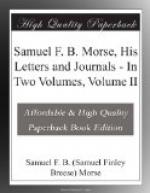Morse, however, always, in every one of his many written references to the matter, speaks of it as “my conventional alphabet.” In an article which I contributed to the “Century Magazine” of March, 1912, I treated this question at length and proved by documentary evidence that Morse alone devised the dot-and-dash alphabet. It will not be necessary for me to repeat all this evidence here; I shall simply give enough to prove conclusively that the Morse Alphabet has not been misnamed.
The following is a fugitive note which was reproduced photographically in the “Century” article:—
“Mr. Vail, in his work on the Telegraph, at p. 32, intimates that the saw-teeth type for letters, as he has described them in the diagram (9), were devised by me as early as the year 1832. Two of the elements of these letters, indeed, were then devised, the dot and space, and used in constructing the type for numerals, but, so far as my recollection now serves me, it was not until I experimented with the first instrument in 1835 that I added the — dash, which supplied me with the three elements for combinations for letters. It was on noticing the fact that, when the circuit was closed a longer time than was necessary to make a dot, there was produced a line or dash, that, if I rightly remember, the broken parts of a continuous line as the means of imprinting at a distance were suggested to me; since the inequalities of long and short lines, separated by long and short spaces, gave me all the variations or combinations of long and short lines necessary to form the alphabet. The date of the code complete must, therefore, be put at 1835, and not 1832, although at the date of 1832 the principle of the code was evolved.”
In addition to this being a definite claim in writing on the part of Morse that he had devised an alphabetic code in 1836, two years before Vail had ever heard of the telegraph, it is well to note his scrupulous insistence on historical accuracy.
In a letter to Professor Gale, referring to reading by sound as well as by sight, occur the following sentences. (Let me remark, by the way, that it is interesting to note that Morse thus early recognized the possibility of reading by sound, an honor which has been claimed for many others.)
“Exactly at what time I recognized the adaptation of the difference in the intervals in reading the letters as well as the numerals, I have now no means of fixing except in a general manner. It was, however, almost immediately on the construction of the letters by dots and lines, and this was some little time previous to your seeing the instrument.
“Soon after the first operation of the instrument in 1835, in which the type for writing numbers were used, I not only conceived the letter type, but made them from some leads used in the printing-office. I have still quite a quantity of these type. They were used in Washington as well as the type for numerals in the winter of 1837-38.




